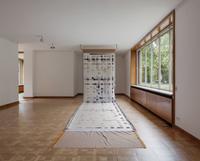Rossella Biscotti10 × 10Mies Van Der Rohe Stipend–Haus Esters
The fifteenth Mies van der Rohe Stipend has been given to Rossella Biscotti. She convinced the jury with her investigations into historical and architectural questions and by the way she has transposed these into sculptures and spatial situations. With her installations, which are based on archive material, interviews, and personal research and encounters, she makes social and political topics directly amenable to the senses.
For Haus Esters, Biscotti has developed a site-specific installation that takes a deeper look not only at the history of the textile industry, but also at the villas that Mies van der Rohe designed for the Krefeld silk manufacturers Josef Esters and Hermann Lange. The boom in the textile industry in the nineteenth century came with the introduction of the Jacquard loom. These looms were the first to use punch cards, which allowed patterns to be woven to almost any degree of complexity. With the introduction of the binary system based on O and 1, the punch code presented an early mechanical storage system that formed the underlying architecture for all data processing to come, and thus paved the way for the modern computer. The punch card system was then further developed by the US American engineer Herman Hollerith in the late nineteenth century for the purposes of recording census data.
Biscotti's new production for Kunstmuseen Krefeld picks up on the history of textile manufacture and its far-reaching technological and social context. She has had specially designed fabrics woven with patterns derived from the use and transformation of statistical data. Although it has a tactile dimension, the work's emphasis lies in the conceptual aspect of the fabric. The technique of weaving serves as leitmotif for Biscotti's exhibition - not only as a concrete means of production, but also on the content level, where it brings together various narratives, timelines and structural levels.
Rossella Biscotti was born 1978 in Molfetta, Italy. Her work has been presented in solo exhibitions at CAC, Vilnius (2012), Secession Vienna (2013) and WIELS Brussels (2014), among others. She participated in the Manifesta 9 (Genk 2012), documenta (13) (Kassel 2012) and the Venice Biennal (2013). 2010 she received the Premio Italia Arte Contemporanea. She lives and works in Brussels.
The Mies van der Rohe Stipend was set up in 1979 so as to support young, promising artists and, through the presentation of the award in the renowned exhibition spaces Lange and Esters, ensure they are brought to international attention. Twelve artists received the renowned distinction in the years between 1982 and 1996, and beginning in 2009 it will once again be awarded on a regular basis. Three external art experts will each propose two artists, and then in a second stage a separate, five-person jury will elect the winner of the Mies van der Rohe Stipend.
